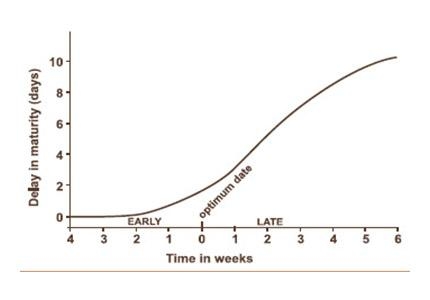To retain snow during the winter, directly seed winter wheat into standing crop stubble. Snow insulates, protecting the crown of winter wheat from the potentially lethal temperatures common to Minnesota winters.
Snow depth
Standing stubble maintains a cooler soil environment so the plant doesn't break dormancy as early in the spring or during a mid-winter thaw, as plants grown on bare ground do. Three inches of snow provides sufficient insulation during most winters, and 4 to 6 inches will further reduce winter kill (Table 1).
Table 1: Predicted daily minimum temperatures at crown depth
| Snow depth | -22F | -44F |
|---|---|---|
| 1.2 to 2.5 inches | 0.9 F | -9.9 F |
| 2.5 to 3.5 inches | 6.1 F | -3.6 F |
| 3.5 to 4.7 inches | 11.1 F | 2.5 F |
| More than 4.7 inches | 20.5 F | 18.1 F |
Direct seeding
You can direct seed winter wheat into a wide range of standing crop residues, though best results are obtained when seeding winter wheat into standing stubble of early maturing crops such as barley and canola.
Seeding into wheat stubble increases the risk of residue-born diseases, but even this practice is preferred to seeding into clean, tilled fields for moisture conservation and reduction of winter kill.
You can successfully produce winter wheat in abandoned alfalfa stands and even after a low-residue crop such as soybeans. When following alfalfa, allow some regrowth in late summer and early fall before killing the stand with a broad spectrum herbicide like glyphosate. Direct seed winter wheat into the killed alfalfa stand.
Following soybeans requires either that the producer selects an early-maturing soybean or delays seeding past the recommended seeding date (Table 2). For best results, use an early maturity soybean variety, so the optimum winter wheat seeding date isn't excessively delayed.
Optimal direct seeding dates
A delay in planting past the optimum seeding date increases the risk for winter kill and can reduce grain yield. This is because the crowns won’t be as well developed and the plant will have had less opportunity to store nutrients (Figure 2).
Table 2: Optimum date for direct seeding winter wheat into standing stubble in Minnesota.
| Location | Date |
|---|---|
| South of Interstate 90 | Sept. 20 to Oct. 10 |
| South of Interstate 94 | Sept. 10 to Sept. 30 |
| North of Interstate 94 | Sept. 1 to Sept. 15 |
Likewise, seeding too early can result in excessive growth in the fall, making plants more vulnerable to winter kill.
Early planting can also create a green bridge, or overlap, between hosts such as volunteer wheat and the emerging winter wheat. This allows many important winter wheat pests to spread to the new winter wheat.
For example, seedling infections of barley yellow dwarf virus and wheat streak mosaic virus can dramatically reduce grain yield.
Growth stage and survivability
Plants that have initiated the first tillers are at the optimum growth stage to go dormant, while plants with two to three tillers will generally survive the winter well.
Plants with only the first leaf emerged can survive Minnesota winters. However, late planting poses the risk of not meeting the vernalization requirement – a physiological change that enables reproductive growth – before dormancy. This will delay maturity the next summer (Figure 3).
Establishing winter wheat
Research in northwest Minnesota has demonstrated that winter wheat can be established well with little risk of winter kill when seeding immediately following soybean harvest in the first days of October.
In the years the research was conducted, the winter wheat was seeded on Oct. 1, immediately following soybean harvest. Growing conditions in the first two weeks of October were mild enough that the winter wheat germinated and the first true leaf emerged prior to the first killing frost, forcing dormancy in the third to fourth week of October.
Reviewed in 2018



